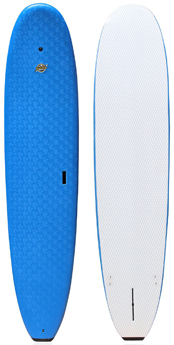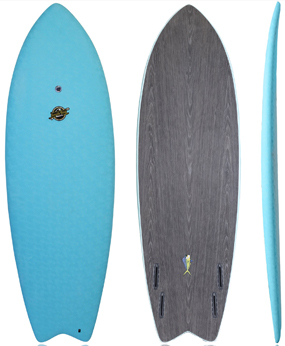Shortboard vs Longboard Surfing
There are so many things to consider when buying a new surfboard and understanding the differences between board types is crucial so that you don't waste a ton of money on the wrong board.
Shortboards and longboards are the two most popular surfboard designs in the surf world, but do you truly understand the difference between the two?
Come with us as we explore the elements of each in our Longboard vs. surfboard guide.
Quick Glance
Our Favorite Longboard Model - South Bay Board Co. Heritage 8'8" →
Our Favorite Shortboard Model - South Bay Board Co Mahi 6' →
More...
Contents
Difference Between a Shortboard vs Longboard
Longboards are somewhat of the original gangsters of surfing. While materials and designs have changed over the decades, the general idea has remained the same. From retro wood surfboards to fiberglass hardtops to foam soft-tops, longboards come in all shapes and sizes.
As you may have guessed, longboards are long. Typically, a longboard is one that is over 8 feet in length. While the larger size makes them difficult to transport, they are much easier to ride thanks to their added buoyancy and stability. Typically, new surfers start out on longboards, as it is much easier to learn the basics of boarding with more surface area. Plus, you can surf much smaller waves.
Shortboards are the polar opposite. These types of boards have only been around for a few decades and are categorized by the fact that they are less than 7 feet long. Shortboards are far more maneuverable compared to longboards and are great for tackling larger and stronger waves.
More often than not, shortboards are made out of fiberglass material and utilize thruster fin setups (three fins). Shortboards are not an ideal choice for beginner surfers because they are hard to paddle and difficult to stand on.
Longboards
Our Favorite Longboard Model - South Bay Board Co. Heritage 8'8"
South Bay Board Co. offers a number of premium soft-top surfboards for beginner and intermediate surfers.
The Heritage longboard comes in at 8'8" long and can hold up to 260lbs.
As for the design, this longboard has a double concave bottom, which allows the water to pass through the channel on the underside of the board so that it flows efficiently past the fins.
With an entry-level rocker, you'll be able to find your balance in the surf with ease.
One thing we absolutely love about this board is the wax-free IXPE fingerprint textured soft-top deck. You never need to worry about waxing it up to ride! It comes with three high-performance fins for a thruster setup and a 9' leash so that you don't lose your board to the waves.
To help protect the board from damage, it comes with a 6 oz resin layer on both the top and the bottom. Pair that with the rubber bumper, the triple stringer system, and the HDPE plastic netting, and you have a board that can withstand the test of time.
One unique feature that we can't go without noting is the heat-release valve, which helps prevent heat damage that is very common with soft-top surfboards, including bubbling and delamination.
Who Longboards Are Perfect For
Longboards are great for beginners because they are much easier to ride and learn on. However, even pro surfers often take out longboards when the waves call for them. Sometimes, small or mushy surf conditions can't be ridden with a shortboard. Having a longboard can turn a flat day into a fun day.
Pros & Cons
Another absolute winner from South Bay Board Co, the Mahi 6' absolutely rips.
With 40L of volume, this small board can easily support surfers up to 220lbs.
While most shortboard models come with thruster setups, this particular shortboard utilizes a quad fin system, giving riders ore stability out in the surf.
It comes with four FCS fins and FCSII Fin Boxes.
The board has hard rails, providing surfers with fast and clean transitions. Y
ou get a nice tail rocker with the Mahi, great for gathering speed. Plus, with added rocker in the nose, the Mahi works to prevent surfers from pearling.
On the inside of the board is an I-Beam Stringer System, which makes use of a heavy-duty wood stringer, which runs from the tail to the nose. Even with its foam design, it is incredibly durable. Similar to the Heritage, this board comes with a heat-release valve to prevent bubbling and delamination.
Who Shortboards Are Perfect For
Shortboards are best for intermediate, advanced, and pro riders; essentially, people who are familiar with the sport. The various aspects of the board help when the surf gets higher and more powerful. More often than not, a heavy wave will be in a steep way, which can be quite uncomfortable when riding with a bulky longboard.
Thanks to the unique shortboard design, you get much better responsiveness and maneuverability.
Pros & Cons
FAQ
Is a longboard easier than a shortboard?
A longboard is absolutely easier to surf. As we said before, a beginner will typically go and hone their surfing skills on a longboard. It is pretty common to catch your first wave while longboarding. For smaller surf breaks and whitewater, going with a longboard is key.
Is it harder to surf on a shortboard?
Beginners will find it much harder to surf on a shortboard compared to a longboard. Due to the small shape, limited volume, and sharper features, shortboards require far more confidence to ride. Getting your feet planted correctly on a shortboard requires a lot more training as well. When surfing a shortboard, you need to learn how to pump and maintain balance, both of which are skills that you develop naturally as you continue your surf joun
Should I longboard or shortboard?
If you are just starting out in the world of surfing, then you should get a longboard. Even furthermore, we would recommend getting a foam board. Longboard foam boards are perfect for getting your balance down and many of them are fairly inexpensive. You'll be able to catch a lot more waves with a longboard than a shortboard.
On the other hand, if you have your surf feet down, can get into turns, and you want to take the next step, a shortboard might be the best choice. If you want to transition from a longboard with ease, we first recommend starting with a funboard. A funboard is somewhat of a hybrid of these two boards with its own unique surfboard designs.
A funboard will be far more maneuverable for a surfer compared to a longboard, though thanks to the added length and rounded body, it is much easier to surf with than a shortboard.
Can a beginner learn to surf on a shortboard?
While shortboarding might look exciting, trying to learn with a shortboard can be an absolute nightmare. Of course, looking out in the water, a pro surfer makes it look easy. However, that kind of style and speed takes years to develop, and your progress can be stifled if you try and take on a shortboard too quickly. Getting started in the sport of surfing means practicing a lot to get your feel and technique down.
As we said before, funboards are a great alternative. With a funboard in hand, you can learn how to surf while still having access to maneuverability. Plus, there are many funboard options out there in all shapes and sizes, meaning it is pretty easy to find one to fit your needs.
Final Thoughts - Longboard Vs. Shortboard
Surfing is one of the most exciting sports in the world, though finding the right type of board for your needs can be difficult, especially with so many options on the market.
When trying to find a solution to the question of longboard vs shortboard, you need to consider the differences and what you are looking to get out of your surfing experience. While longboards aren't very maneuverable, they do offer tons of stability when surfing. Shortboards, on the other hand, are very fast and agile in bigger waves, though these boards can be difficult for new surfers to ride with shorter length.
Of course, your best bet is to try these different boards out to see which one works best for you, your skill level, and the type of waves you're riding.
The best way to find the right type of board for your surfing needs is to head down to your local surf shop and ask questions.


